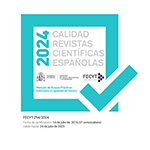Kleider machen Leute: Clothing as a Social Metaphor in Grimmelshausen’s Der Abenteuerliche Simplicissimus Teutsch
Resumen
El presente artículo desarrolla los enfoques y observaciones de Lynne Tatlock y Peter Hess sobre género e identidad, abordando la significación simbólica de la elección de vestimenta (o falta de elección) de Simplicissimus para su desarrollo moral en Der Abenteurliche Simplicissimus (1668) de Hans Jakob Christoffel von Grimmelshausen. Mi estudio investiga cómo utiliza el autor los objetos cotidianos como las prendas de vestir para comunicar papeles con jerarquía social y desarrollo moral. La progresión moral y regresión de Simplicissimus (su búsqueda moral) se hace visible a través de las diversas etapas en la vestimenta, tanto por lo que respecta a los trajes que él elige como a los elegidos para él. En este texto el atuendo no es sólo una metáfora de estatus sino que comunica también desarrollo moral. Cuando se transgreden las normas Simplicissimus se encuentra en su nivel moral más bajo y cuando no se trangreden en el superior. Su Schein und Sein (apariencia y ser verdadero) encajan armónicamente sólo cuando él asume las elecciones de vestimenta que realizan otros para él. Leer el desarrollo moral de Simplicissimus en contra, literalmente, de la tela de su vestimenta permite respaldar interpretaciones previas, tales como la de Jan Scholte, sobre la estructura dramática invertida de la novela y abre importantes y nuevos caminos de investigación.Descargas
Descarga artículo
Licencia
La Revista de Filología Alemana, para fomentar el intercambio global del conocimiento, facilita el acceso sin restricciones a sus contenidos desde el momento de su publicación en la presente edición electrónica, y por eso es una revista de acceso abierto. Los originales publicados en esta revista son propiedad de la Universidad Complutense de Madrid y es obligatorio citar su procedencia en cualquier reproducción total o parcial. Todos los contenidos se distribuyen bajo una licencia de uso y distribución Creative Commons Reconocimiento 4.0 (CC BY 4.0). Esta circunstancia ha de hacerse constar expresamente de esta forma cuando sea necesario. Puede consultar la versión informativa y el texto legal de la licencia.










